Second Attempt at Proper Bunny Housing
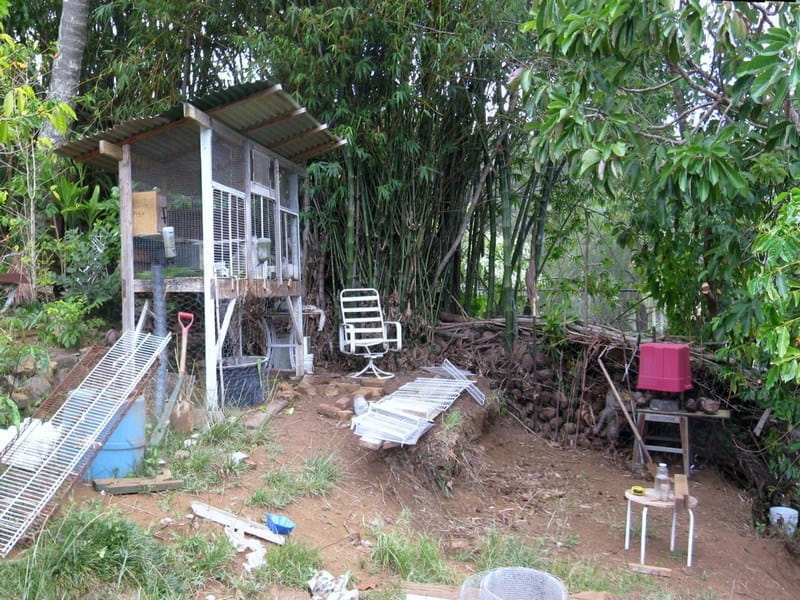
This is where 'Hillside Farm Hawaii' continued it's name. Folks like to name their 'rabbitry' (I'm not sure if that word will pass your basic spellcheckers, but it's a common word in the rabbit world) and we were considering all sorts of names involving fuzzy bunnies, but we already had a small farm named 'Hillside Farm' so the new rabbitry (if one can call just two bunnies by such a grandious moniker) just kinda continued the "Hillside" trend.
However, that was then, this is now, and we no longer farm on a hillside and no longer have the little farm since it was leased farmland. We still have the bunnies and we're still on a backyard hillside and we've had the name for too long now to change anyway so "Hillside Farm Hawaii" we remain. I suppose we could become "Hillside Farm Hawaii Rabbitry" but that takes too long to say and write and gets tangled up in words folks aren't familiar with so we will just keep it simple and keep it 'Hillside Farm'. Surprisingly enough, we aren't the only folks foolish enough to farm on a hillside so we had to add the "Hawaii" part to tell us apart from the other "Hillsides". Not that what we call ourselves really matters, we're supposed to be discussing bunny spaces.
This second attempt to define proper bunny housing was soon after we got our first pair of English angoras. They were Bumblebeeacres Forever, who we called 'Cloud' and her son, Tails of Paradise Stealth. Who, for what seems to me obvious reasons, we called Zephyr. I mean, really, what kind of name is that for a rabbit? Their pedigrees didn't show up for several months after they'd arrived and they were sold to us as a "breeding pair". Had the pedigrees arrived before the rabbits we probably would have not bred them, but their offspring turned out okay once we figured out how to give the doe a proper nest area.

Katie the Pest guarding her bunnies and trying to figure out how to roll in the manure below.
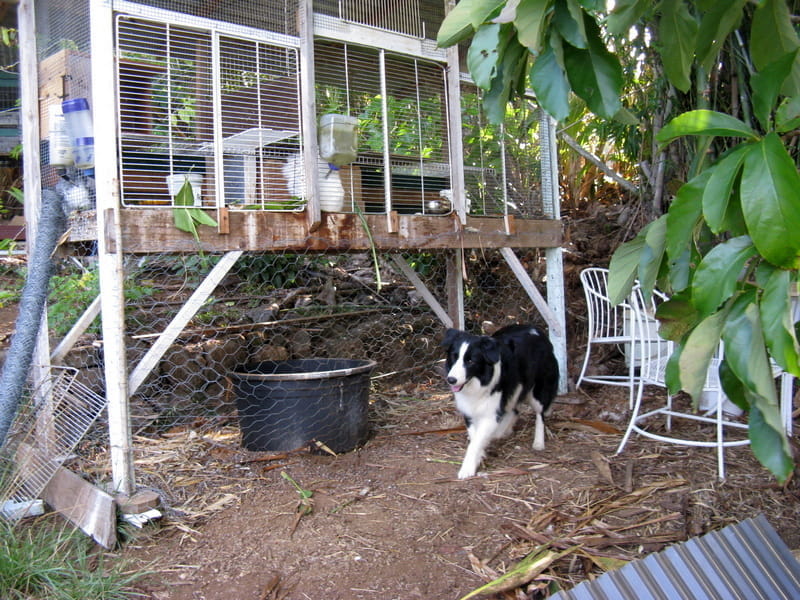
Katie the Pest still guarding her bunnies. Border Collies are generally busy dogs.
For some reason, chickens and dogs like bunny manure. The chickens generally scratch it all over the place and look for worms and bugs. The dogs always seemed to want to either roll it in or eat it or some of each. It's not overly smelly for being a manure and it's excellent for the garden. If one has bunnies, there should be a garden nearby somewhere, the manure is that good. Folks come by and clean under the hutches for me occasionally although sometimes it's already gone into our own gardens. Using a wire floor allows for the manure to fall through to where it can be easily collected and used, providing you can keep the dogs and chickens out of it.
This hutch was built after we found out that 1/2" x 1" wire makes a good floor for an angora rabbit hutch. We've pretty much always used the same style of wire ever since. Angoras have long wool which will drag through anything in their hutch. Kinda like a Swiffer they are. The wire allows for 'things' to fall through and not get tangled in their wool. The English angoras also have fluffy feet and they don't weigh all that much so they don't mind the wire. We give them some flat places to sit as well, should their feet get tired of wire, but they aren't always on the flat spots.

Cloud and Zephyr trading gossip on a lazy afternoon
One of the features of this bunny hutch was that the doe and the buck could 'chat' with each other through the wire rack separating their spaces. Bunnies are pretty social and they like being near other bunnies. Even if it's just the scent of other bunnies, they seem happier and calmer when they are part of a 'herd'.
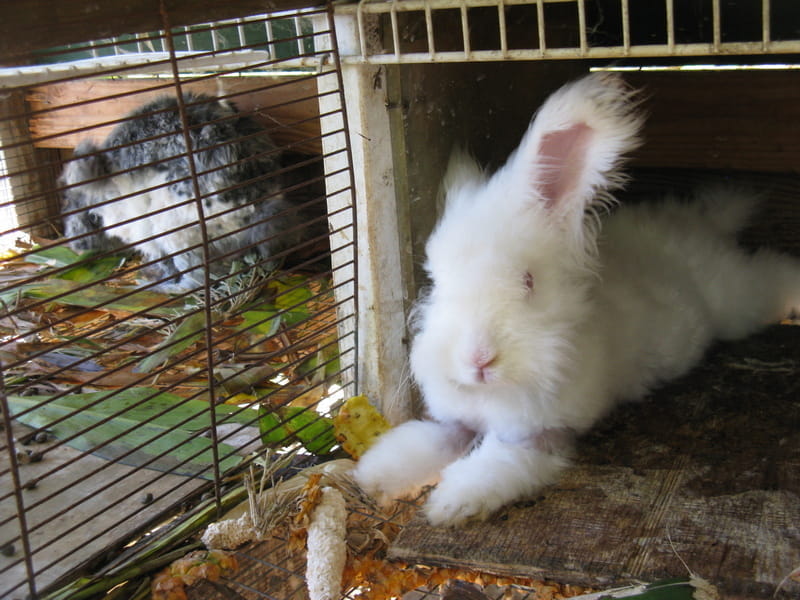
Cloud's favorite lounging spot
Even though Cloud had a larger area to roam in than Zephyr did, she would still frequently be over by their 'backyard fence' so she would be able to be near Zephyr. This was a pretty big hutch for just two bunnies. It was eight feet long and two and a half feet wide with an upper ledge across the back. Not sure how much floor space that came out to, but it was quite roomy for just two buns. Zephyr had a space that was about three and a half feet wide and Cloud had the rest.
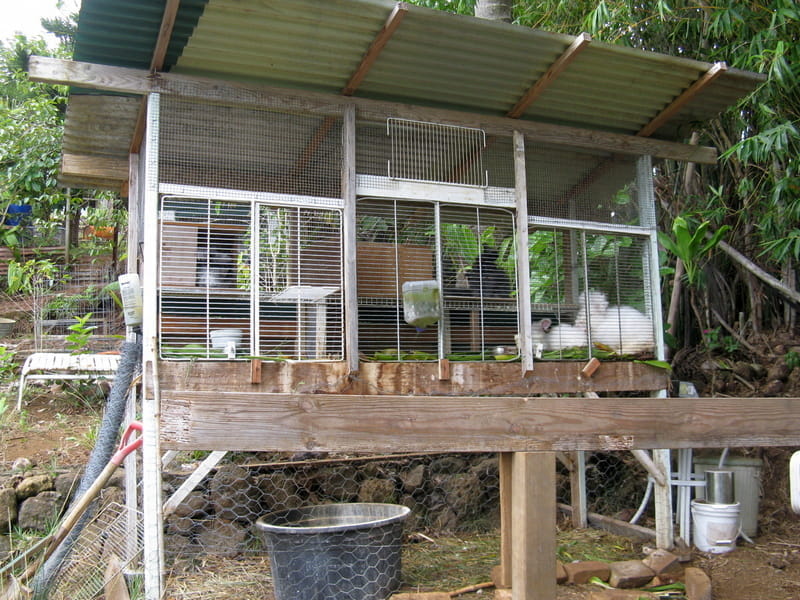
Zephyr's space on the left and Cloud's space on the right
Here's a front view of the hutch. Zephyr has his two level space on the left and Cloud has her bigger space on the right. By this point, she's sharing with the litter she'd had so she needed more space.

Cloud and some of her babies
This is Cloud with some of her babies. Offspring between Cloud and Zephyr were always either black or albino, which was another reason why more bloodstock was brought in. In this picture, her babies are about three months old from the looks of them. Baby bunnies are born hairless and not overly cute. From about three weeks until about three months are their cutest time. But since there were now baby bunnies, we had to start building another hutch. That actually happens fairly frequently with bunnies. Kinda like potato chips, it's hard to have just one.
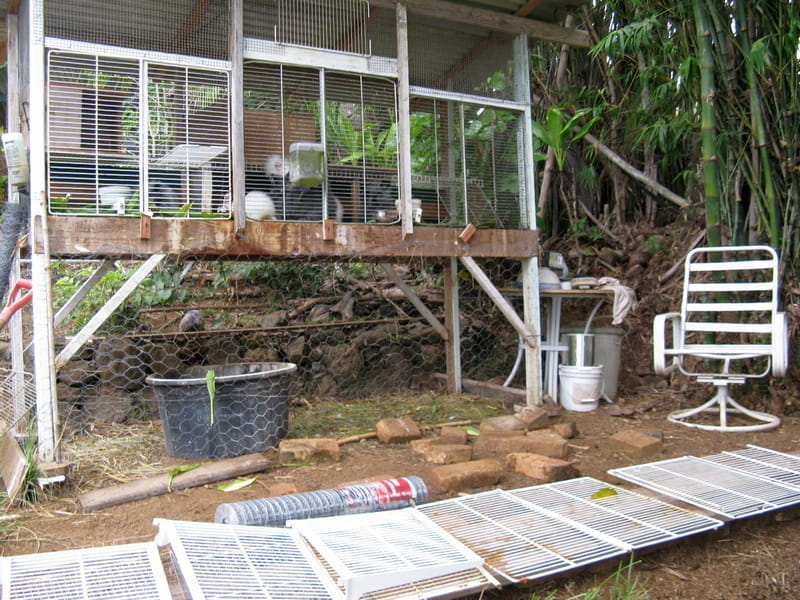
Measuring for the next hutch
When one has bunnies, it seems there's frequently an increased need for more bunny space. Cloud's babies were getting bigger and we needed another hutch. Since the wood framed hutch had worked well for the first hutch, we continued with the same construction technique for the next one. It also used up a lot of stuff we just had laying about. We did buy the floor wire, the rest was sort of scavenged from whatever was available.
To figure out the dimensions, especially since these hutches were made with found materials, we 'measured' them by laying out the doors and then figuring out how long the hutch needed to be. We have access to old refrigerator racks and they're nice sturdy racks so we used a lot of them in the construction. We did find out though, that they aren't good for hutch floors. One of the bunnies got a foot caught and ended up with a broken leg. It was splinted and the bunny got better, but it would have been much better to not have had the problem in the first place. So, if using racks for floors, make sure the wires are fairly close together. The 1/2" x 1" wire mesh works great since it's wide enough for stuff to fall through and tight enough to keep bunny feet from getting caught.
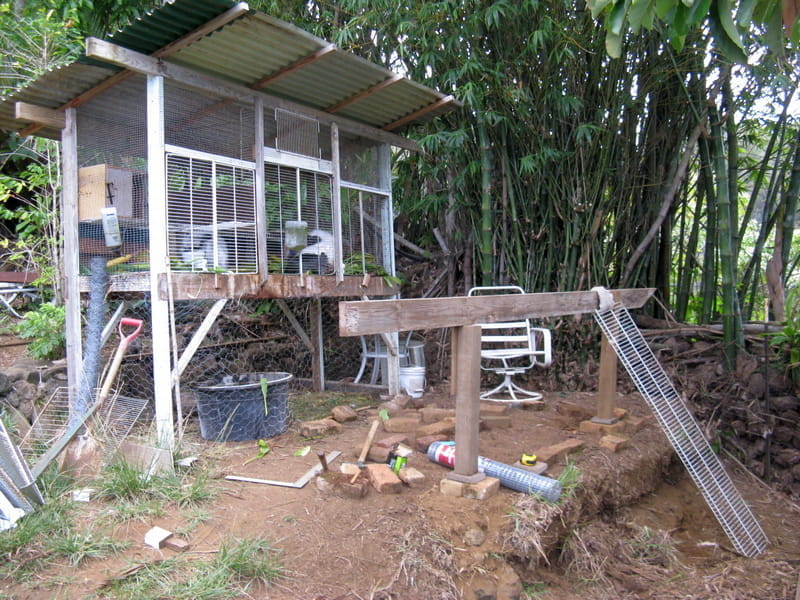
The first big floor beam
When we were building these hutches, we put up the floor beam first, then some walls, then a roof support, kinda like how houses are built. Later on we switched to a different method, but at the time, it was floor beams first, then walls.
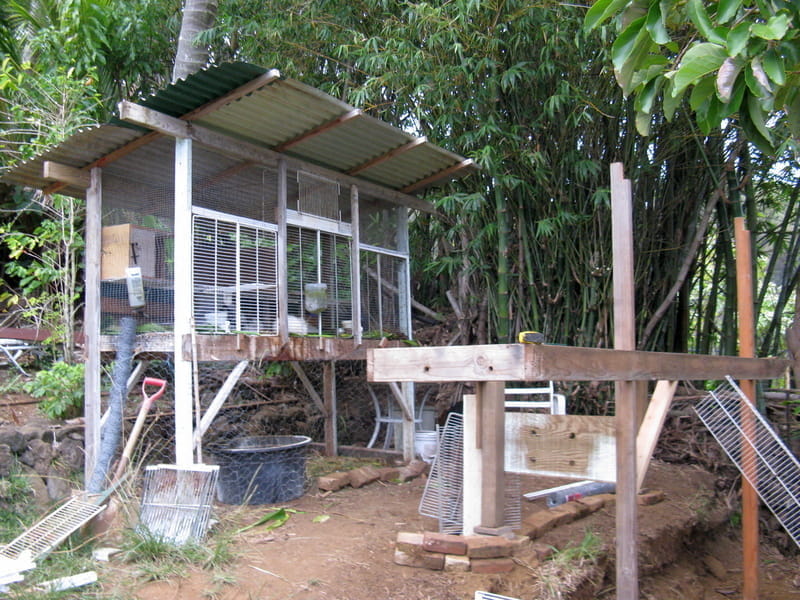
A few more parts added
This was kinda an awkward way to build the hutches, but it worked after a fashion. We were using pretty much whatever we had laying around so our choices were much more driven by what was available instead of the easy way to do it. There's a brick on the ground, then a bit of Trex decking which is a waterproof material used to make lanai decks with sometimes. That's to keep the water in the brick from traveling up into the post and causing rot. Then a 4" x 4" post which is overkill for a mere bunny hutch, but we had it laying around. The back legs were 2" x 4"s and these are already notched for the roof beam. Much easier that way.
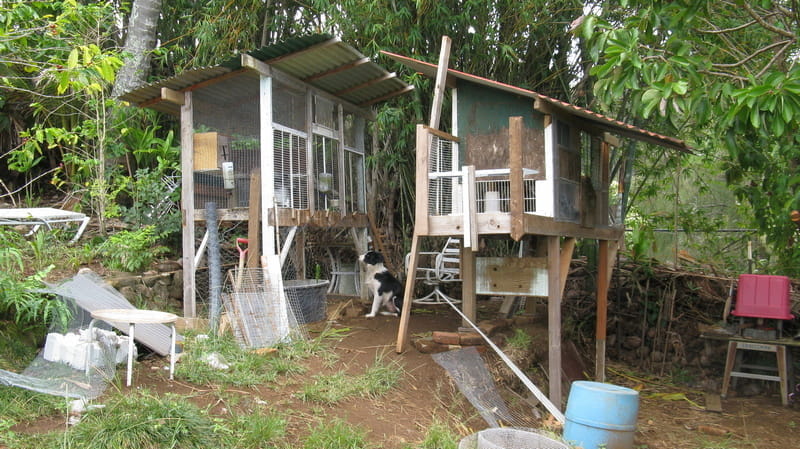
Katie the Pest still guarding her bunnies and now there's two hutch fulls to guard.
The second hutch is getting more complete, although the end hutch space is still not finished. Some interesting things in this picture are the pink container covering the hydraulic coconut cracker over on the right side of the picture. If you notice, there's the trunk of a coconut tree on the left side of the picture. Occasionally one would land on the hutch roof with rather a loud "KABANG!" and then the bunnies jump, but they do like eating coconuts. Dogs and chickens like them, too. As well as people. We don't have any coconuts in the current bunny yard, but I've planted a few up where the bunny yard will be next. Next time a set of face-to-face hutches are built, I'll connect the roof at the top so the rain won't be an issue.
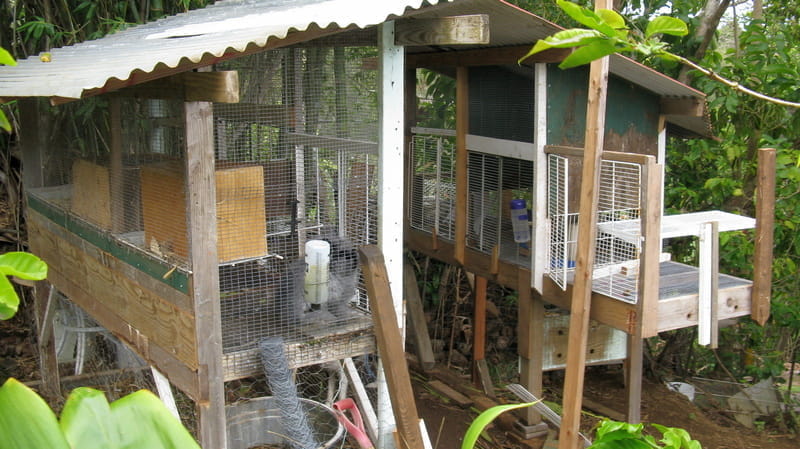
Different view of the two hutches
Here's a different view of the same two hutches. The doors are made of refrigerator racks and most of them are different sizes so building the hutches are a bit of a fussy find something that fits sort of construction. Generally it takes longer to find the parts than to install the parts. Another interesting thing in this picture is the solid part of the back in the first hutch. That section of ply wood did a lot to stabilize the whole hutch.
We learned a lot building these hutches, although we didn't get to use them very long. We started with bunnies in 2009 and moved to town late in 2010, so these hutches were only in use for several years. The third hutch wasn't even completely finished before we bought another house and moved to town. Which was a good thing, but then we needed to build more bunny hutches. The next bunny yard in town was lovely since it was in the corner of a flat lot with lots of nearby fruit trees. Not being on a hillside is a much easier way to have livestock. The link for the next hutch isPhase Two of 'New and Improved' Bunny Hutches